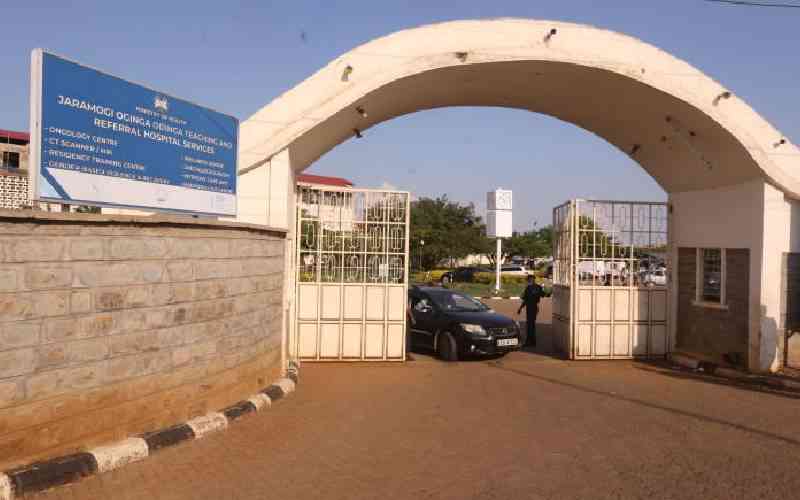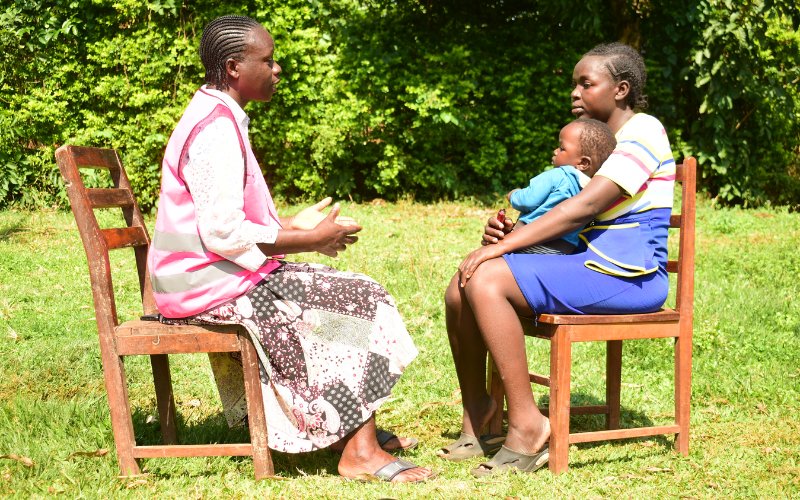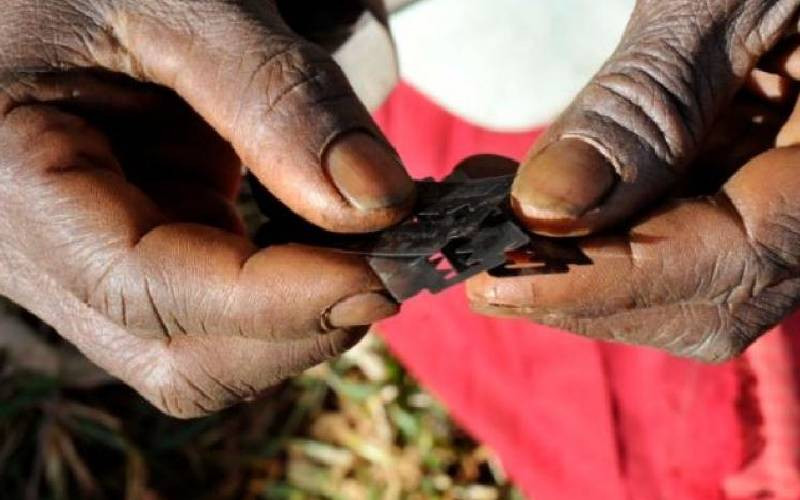
In March 2020, Jane Rono thought she was expecting a child since her stomach was swollen. She had also started feeling more exhausted than usual and had lost a lot of weight. This sudden shift in her health prompted her to go to a nearby hospital.
After several tests, it turned out she was not expectant, and was referred to Nairobi Hospital for further tests, where the results showed Chronic Myeloid Leukaemia (CML).
CML is a type of white blood cell cancer that is caused due to an acquired genetic defect. This causes bone pain, fever, night sweats, easy bleeding, fatigue, an enlarged spleen, and weight loss.
“All my life, I have known cancer as a death sentence, so the diagnosis took a huge toll on me emotionally. I didn’t know where to go or start,” she narrates.
Apart from the emotional toil, Rono, a mother of three and a form four leaver, says her husband, who is a farmer, could not sustainably support both of them and the children financially, and now here was an additional burden of a cancer diagnosis.
Luckily, Rono was introduced to a doctor who runs a free program (consultation, treatment, and medication) for CML patients who cannot afford treatment. Although there was a glimmer of hope for her, Rono still struggled to find medication that worked.
“First and second-line medications could not work…I would cry a lot; I thought I was going to die. But my doctor encouraged me and told me to be patient.”
- Kenyan oncologist wins global award for leukemia work
Keep Reading
Thanks to counselling and encouragement from her doctor, Rono now takes her diagnosis with more grace and handles it like any other disease.
“It’s just like malaria or any other condition. Cancer is not a death sentence, as long as you take your medication and eat properly.” She says.
Rono comes to the Nairobi Hospital every three months for a free consultation and medication. Although the financial burden has partially been lifted, she has to incur transport and laboratory test costs.
“I have to do a BCR test every six months, and it costs Sh 18,000. I also have to do annual bone marrow tests, which cost more than Sh 10,000,” she says.
Rono says she would not be alive if she had to buy the medication, which averagely costs Sh 300,000 per month. For CML patients with more chronic conditions, the treatment averagely amounts to about Sh 600,000 per month, an amount many cannot afford.

Silvance Bita, a teacher from Migori County, has been battling CML since 2006 when he started feeling extremely tired after walking short distances.
“Moving uphill was a problem. One time, I was playing with a child under a tree, and the child was bouncing on my stomach. I was feeling so much pain. When I touched my stomach, it felt like a ball.”
When it came to feeding, the husband and father of six says he would not eat well since he would feel so full even after drinking some water.
“I would go for general tests in Homa Bay every week until one day they told me to do a bone marrow test in Kisumu. The tests were inconclusive, and I had to be referred to Nairobi for further tests.”
After discovering that he had CML, Bita was then enrolled in the same program as Rono, where he started taking the free medication.
“I started feeling better after one week. I could now feed well and would feel less tired. Bita takes four tablets every day, which cost about 80,000 shillings. I am so grateful that I can access these medications. If it were not for these drugs, I would have died in 2008,” he says.
Rono and Bita are part of Henzo Kenya, a Community-Based Organization that brings together cancer patients mainly for public awareness, mutual support and advocacy. Their main focus is Chronic Myeloid Leukemia (CML) and Gastro-intestinal stromal tumors (GIST) patients.
Rono says that being part of the Henzo support group has helped them cope with the challenges that come with cancer.
“I feel like I’m not alone in this journey. Sometimes I encounter someone even worse than me, and I have to be a source of encouragement for them,” says
Elo Mapelu, the chairman of Henzo Kenya, says they sometimes pay transport costs for patients who are not able to afford to travel for treatment.
“Lives are being saved here. Without the treatment, many of these patients would not be able to survive because this cancer is aggressive. He adds that most of these patients have been on treatment for a long time: “The oldest has been receiving treatment for 19 years.”

According to Dr. Othieno Abinya, an oncologist and hematologist at the Nairobi Hospital, BCR-ABL1 genetic testing is most often used with other tests to diagnose or rule out two specific types of blood cancer: Chronic myeloid leukemia (CML) and Philadelphia-positive acute lymphoblastic leukemia (Ph+ ALL). This is a type of acute lymphoblastic leukemia that has the Philadelphia chromosome.
“Certain types of BCR-ABL1 testing may also be used to help plan treatment for these blood cancers. There are several treatment options. Some medicines target the protein made by the BCR-ABL1 gene. In general, these types of medicines cause less harm to normal cells than cancer chemotherapy or radiation therapy do.”
Dr. Abinya explains that the abnormal BCR-ABL1 gene is made when two separate genes merge together and become one gene. Genes are short sections of DNA. DNA is made of long strands of material that carry information that controls what you look like and how your body works. DNA is packaged into structures in your cells called chromosomes. Normally, most of your cells have the same set of 23 pairs of chromosomes.
“The abnormal BCR-ABL1 gene is formed when pieces of chromosomes 9 and 22 break off and trade places. The broken piece of chromosome 9 includes part of the ABL1 gene. It attaches (fuses) to part of the BCR gene on chromosome 22. This makes the abnormal fusion gene, BCR-ABL1.”
The changed chromosome 22 is called a "Philadelphia chromosome" after the city where researchers discovered it.
According to the World Health Organization, your genes carry special instructions for making proteins that help your cells do their work. But the abnormal BCR-ABL1 gene has instructions for an abnormal protein. The protein causes certain bone marrow cells to make large numbers of abnormal white blood cells. These abnormal white blood cells are leukemia cells. They don't protect you from infections like healthy white blood cells do. They can build up in the blood and bone marrow and crowd out healthy blood cells.
“In people with leukemia, cancerous blood cells can enter the spleen and other organs through the bloodstream or the lymphatic system. These abnormal blood cells replicate out of control and can cause the spleen to swell,” explains Dr. Abinya.
The main treatment drugs for CML are Imatinib and Nilotinib. According to Dr. Abinya, Imatinib works by stopping the Bcr-Abl tyrosine kinase.
“This can slow growth or result in programmed cell death of certain types of cancer cells. Nilotinib also works the same way, but it is more effective for newly diagnosed patients and those who have not responded well to other treatments, such as imatinib,” he explains.
These costly drugs come with side effects, including vomiting, diarrhea, muscle pain, headache, and rash. Severe side effects may include fluid retention, gastrointestinal bleeding, bone marrow suppression, liver problems, and heart failure. Use during pregnancy may result in harm to the baby.
“If a CML patient wants to have children, we sometimes have to stop the medication for some time,” Dr. Abinya adds.
 The Standard Group Plc is a multi-media organization with investments in media
platforms spanning newspaper print
operations, television, radio broadcasting, digital and online services. The
Standard Group is recognized as a
leading multi-media house in Kenya with a key influence in matters of national
and international interest.
The Standard Group Plc is a multi-media organization with investments in media
platforms spanning newspaper print
operations, television, radio broadcasting, digital and online services. The
Standard Group is recognized as a
leading multi-media house in Kenya with a key influence in matters of national
and international interest.











